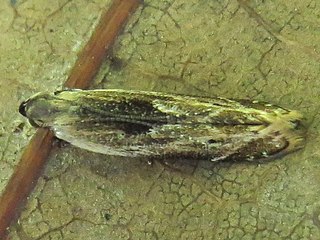
Apamea crenata, known as the clouded-bordered brindle, is a moth in the family Noctuidae. It is distributed throughout the Palearctic realm. In the North it crosses the Arctic Circle, in the Mediterranean it is found only in cool locations and mountains avoiding very hot areas. In the Alps, it rises to an altitude of about 2000 metres.

Cepora nadina, the lesser gull, is a small to medium-sized butterfly of the family Pieridae, that is, the yellows and whites. The species was first described by Hippolyte Lucas in 1852. It is native to Sri Lanka, India, Myanmar, Hainan, and southeast Asia.
Naera is a genus of moth in the family Gelechiidae. It contains the species Naera fuscocristatella, which is found in North America, where it has been recorded from Alabama, Kansas, Louisiana, Mississippi, Tennessee and Texas.
Sorhagenia pexa is a moth in the family Cosmopterigidae. It was described by Ronald W. Hodges in 1969. It is found in North America, where it has been recorded from Texas, Arkansas and Illinois.
Dichomeris procyphodes is a moth in the family Gelechiidae. It was described by Edward Meyrick in 1922. It is found in Amazonas, Brazil.
Helcystogramma daedalea is a moth in the family Gelechiidae. It was described by Walsingham in 1911. It is found in Mexico (Tabasco).
Hypatima dissidens is a species of moth in the family Gelechiidae. It was described by Edward Meyrick in 1913. It is found in Mpumalanga, South Africa.
Hypatima euplecta is a species of moth in the family Gelechiidae. It was described by Edward Meyrick in 1904. It is found in Australia, where it has been recorded from Queensland, New South Wales, Victoria and South Australia.
Pseudotelphusa fuscopunctella is a moth of the family Gelechiidae. It is found in North America, where it has been recorded from Arkansas, Florida, Georgia, Illinois, Indiana, Kentucky, Maine, Mississippi, Pennsylvania, New Jersey, South Carolina and West Virginia.
Calliprora platyxipha is a moth of the family Gelechiidae. It is found in Brazil.
Compsolechia repandella is a moth of the family Gelechiidae. It was described by Francis Walker in 1864. It is found in Mexico, Colombia, southern Brazil and Guyana.
Leucogoniella subsimella is a moth of the family Gelechiidae. It was described by James Brackenridge Clemens in 1860. It is found in North America, where it has been recorded from Pennsylvania and Texas.
Anacampsis tristrigella is a moth of the family Gelechiidae. It was described by Thomas de Grey in 1882. It is found in North America, where it has been recorded Alabama, Arkansas, Manitoba, Massachusetts, Mississippi, Ontario, Quebec, Tennessee and Texas.
Anacampsis tephriasella is a moth of the family Gelechiidae. It was described by Vactor Tousey Chambers in 1872. It is found in North America, where it has been recorded from Illinois, Kentucky and Maine.

Aristotelia rubidella is a moth of the family Gelechiidae. It was described by James Brackenridge Clemens in 1860. It is found in North America, where it has been recorded from Alabama, Alberta, Arkansas, British Columbia, California, Florida, Georgia, Illinois, Indiana, Iowa, Kentucky, Louisiana, Maine, Manitoba, Maryland, Massachusetts, Michigan, Mississippi, New Jersey, North Carolina, Ohio, Oklahoma, Ontario, Quebec, South Carolina, Tennessee, Texas, Virginia, Washington, West Virginia and Wisconsin.
Metzneria castiliella is a moth of the family Gelechiidae. It was described by Heinrich Benno Möschler in 1866. It is found in Portugal, Spain, on Malta, the Canary Islands, in North Africa, on Crete, Cyprus and in Palestine.

Monochroa gilvolinella is a moth of the family Gelechiidae. It was described by James Brackenridge Clemens in 1863. It is found in North America, where it has been recorded from Illinois, Indiana, Mississippi, New Hampshire and Pennsylvania.
Chrysoesthia lingulacella, the silver-banded moth, is a moth of the family Gelechiidae. It was described by James Brackenridge Clemens in 1860. It is found in North America, where it has been recorded from Alberta, Arizona, California, Illinois, Indiana, Iowa, Maine, New Hampshire, Quebec and Texas.
Antaeotricha ptycta is a species of moth of the family Depressariidae. It is found in Guatemala, Panama, Ecuador, the West Indies and Guyana.

Tingena ancogramma is a species of moth in the family Oecophoridae. It is endemic to New Zealand and has been found in the Hen and Chicken Islands, the North Island and the South Island. Adults are on the wing in summer and autumn and inhabit open areas of forest scrubland.





